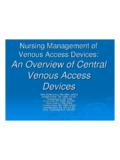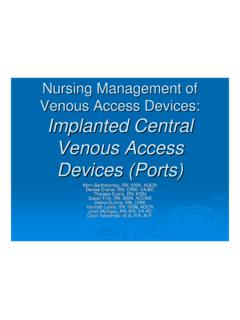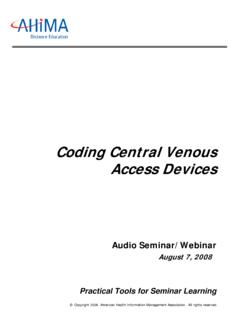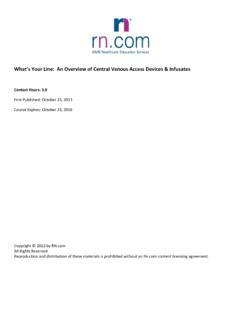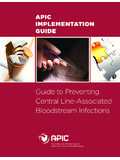Transcription of Diagnosis and Treatment of Vascular Air Embolism
1 REVIEW ARTICLED avid C. Warltier, , , EditorAnesthesiology 2007; 106:164 77 Copyright 2006, the American Society of Anesthesiologists, Inc. Lippincott Williams & Wilkins, and Treatment of Vascular Air EmbolismMarek A. Mirski, , ,* Abhijit Vijay Lele, , Lunei Fitzsimmons, , Thomas J. K. Toung, This article has been selected for theAnesthesiologyCME Program. After reading the article, go to to take the test and apply for Cate-gory 1 credit. Complete instructions may be found in theCME section at the back of this air Embolism is a potentially life-threatening eventthat is now encountered routinely in the operating room andother patient care areas. The circumstances under which phy-sicians and nurses may encounter air Embolism are no longerlimited to neurosurgical procedures conducted in the sittingposition and occur in such diverse areas as the interventionalradiology suite or laparoscopic surgical center.
2 Advances inmonitoring devices coupled with an understanding of thepathophysiology of Vascular air Embolism will enable the phy-sician to successfully manage these potentially challenging clin-ical scenarios. A comprehensive review of the etiology anddiagnosis of Vascular air Embolism , including approaches toprevention and management based on experimental and clini-cal data, is presented. This compendium of information willpermit the healthcare professional to rapidly assess the relativerisk of Vascular air Embolism and implement monitoring andtreatment strategies appropriate for the planned invasive Vascular air Embolism (VAE) was re-ported as early as the 19th century, in both pediatric andadult practice. Well over 4,000 articles have been pub-lished during the past 30 yr alone, providing ampleresonance to the ubiquity and seriousness of this vascu-lar event.
3 Perhaps the most striking feature accumulatedduring this period is the myriad of clinical circumstancesin which VAE may present itself, a result primarily of theincreased technological complexity and invasiveness ofmodern therapeutics. Most episodes of VAE are likelypreventable. This article provides a systematic review ofthe pathophysiology and clinical presentation of thisacute phenomenon, as well as an in-depth analysis andalgorithms for favorable methods of detection, preven-tion, and air embolismis the entrainment of air (orexogenously delivered gas) from the operative field orother communication with the environment into thevenous or arterial vasculature, producing systemic ef-fects. The true incidence of VAE may be never known,much depending on the sensitivity of detection methodsused during the procedure.
4 In addition, many cases ofVAE are subclinical, resulting in no untoward outcome,and thus go unreported. Historically, VAE is most oftenassociated with sitting position craniotomies (posteriorfossa). Although this surgical technique is a high-riskprocedure for air Embolism , other recently describedcircumstances during both medical and surgical thera-peutics have further increased concern about this ad-verse event. Conditions during which air Embolism hasbeen documented have substantively broadened, andmuch of the credit is owed to Albinet 4for theirdescription of the pathophysiology during a variety ofsurgical procedures. Not only does the historicmodusoperandiof a gravitational gradient remain a concern,but we must now as well be suspicious of VAE duringmodern procedures where gas may be entrained underpressure, both within the peritoneal cavity orviavascu-lar access.
5 Hence, it is imperative for anesthesiologists tobe aware of the causes of VAE, its morbidity, diagnosticconsiderations, Treatment options, and adoption of prac-tice patterns that best lead to the prevention of thispotentially fatal two fundamental factors determining the morbid-ity and mortality of VAE are directly related to thevol-umeof air entrainment andrateof accumulation. Whendealing simply with air being suctioned by a gravitationalgradient, these variables are mainly impacted by theposition of the patient and height of the vein withrespect to the right side of the heart. Experimental stud-ies have been conducted using several animal models toassess the volume of VAE necessary to provoke circula-tory collapse. Lethal volumes of air entrained as an acutebolus have been concluded to be approximately ml/kg in rabbits5and ml/kg in ,7 Translating such data into the adult human would bedifficult, if not for some parallel confirmation from theclinical literature.
6 From case reports of accidental intra- Vascular delivery of air,8,9the adult lethal volume has*Associate Professor, Fellow in Anesthesiology, from the Neurosciences Critical Care Division, Department of Anes-thesiology and Critical Care Medicine, Johns Hopkins Medical Institutions, Balti-more, Maryland. Submitted for publication November 24, 2003. Accepted forpublication August 23, 2006. Support was provided solely from institutionaland/or departmental correspondence to Dr. Mirski: Department of Anesthesiology andCritical Care Medicine, 600 North Wolfe Street, Meyer Building 8-140, Baltimore,Maryland 21287. Individual article reprints may be accessedat no charge through the Journal Web site, , V 106, No 1, Jan 2007164been described as between 200 and 300 ml, or 3 5ml/kg.
7 The authors of these reports suggest that thecloser the vein of entrainment is to the right heart, thesmaller the required lethal volume rate of air entrainment is also of importance,because the pulmonary circulation and alveolar interfaceprovide for a reservoir for dissipation of the intravasculargas. As early as 1969, it was shown by Flanaganet a pressure decrease of 5 cm H2O across a 14-gaugeneedle (internal diameter of mm) is capable of trans-mitting approximately 100 ml of air/s. This rate of en-trainment easily exceeds lethal accumulation if not ter-minated immediately. Such data highlights the risk ofcatastrophic VAE in many Vascular procedures per-formed in patients, because the luminal size is wellwithin the diameter of commonly placed hardware.
8 Ifentrainment is slow, the heart may be able to withstandlarge quantities of air despite entrainment over a pro-longed period. As shown by Hybels,11dogs were able towithstand up to 1,400 ml of air over a volume and rate of air accumulation are depen-dent on the size of the Vascular lumen as well as thepressure gradient. The risk of VAE is also present undercircumstances that prevent the collapse of veins even atmodest decreases of pressure relative to that in thevenous system (surgical dissection). Not only negativepressure gradients but also positive pressure insufflationof gas may present a serious VAE hazard. Injection of gas(or liquid air mixtures), such as into the uterine cavityfor separation of placental membrane or for a variety oflaparoscopic procedures, poses a risk for animal experiments indicated that VAE increasesmicrovascular of the rightventricular chamber has been shown to induce pulmo-nary hypertension related to the release of endothelin 1from the pulmonary microbubblesformed due to turbulent flow in the circulation precipi-tate platelet aggregation and the release of platelet acti-vator inhibitor.
9 This, in turn, may lead to systemic in-flammatory response physical and chemical responses may cause in-jury to the pulmonary capillary network, leading to pul-monary 20 Another mechanism of lung injuryincludes toxic free radical damage. An argument hasbeen made to attenuate pulmonary edema with highdoses of steroids such as pathophysiologic pathways may be elucidatedafter a substantive volume of air or gas pathway is manifested is greatly dependent onthe volume of gas accumulated within the right ventri-cle. If the Embolism is large (approximately 5 ml/kg), agas air-lock scenario immediately occurs. There may becomplete outflow obstruction from the right ventricle asfailure from the inability to decompress the tension ofthe ventricular wall.
10 This rapidly leads to right-sidedheart failure and immediate cardiovascular more modest volumes of VAE, the Embolism maystill result in significant right ventricular outflow obstruc-tion, with an attendant decrease in cardiac output, hy-potension, myocardial and cerebral ischemia, and evendeath. Even if the cardiac output remains above thatrequired for adequate perfusion, the Embolism maynonetheless impart significant and even lethal injury. Airentrainment into the pulmonary circulation may lead topulmonary vasoconstriction, release of inflammatory me-diators, bronchoconstriction, and an increase in ventila-tion/perfusion PresentationVascular air Embolism may have cardiovascular, pul-monary, and neurologic sequelae. The spectrum of ef-fects is dependent on the rate and entrained volume ofVAE, as well as other two additional factors: whether thepatient is spontaneously breathing, yielding negativethoracic pressure during respiratory cycle with facilita-tion of air entrainment, or under controlled positive-pressure ventilation.


